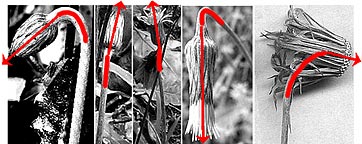
 Series of peduncle/head orientations from bud to dispersal: C. texana (left) & C. carduacea (right)
Series of peduncle/head orientations from bud to dispersal: C. texana (left) & C. carduacea (right)
The ‘Nodding’ of Chaptalia Heads Revisited
by Bob Harms

The ‘nodding’ behavior of Chaptalia in general is poorly understood and badly described, often even utilized in keys to distinguish species. (For examples of this.)
Not until I had closely monitored the nodding behavior of individual heads and individual plants over the course of a year did I begin to realize its complexity. The difficulty in part also stems from failure to grasp the role of ontogenetic, diurnal, as well as seasonal aspects of what is going on.
Most frequently encountered are attempt to describe it with ill–defined ontogenetic terms: in bud, young, immature, at anthesis, in flower(ing), in fruit, at fruit maturity. Totally ignored are significant factors such as diurnal changes in head position, heliotropism, and the role of seasonal changes. (For discussion and illustrations of a number of these.)
The following are presented in an attempt to define more precisely some of the terms needed to describe ‘nodding’:
- anthesis
- The period from the initial display of pistillate floret style branches until all pistillate floret style branches are enveloped by pappus bristles; generally 4—7 days. This is most apparent when the pappus of the peripheral florets is exserted from the involucre. The term is here applied to the head as a whole, not individual florets.
- phase:
- A seasonal variation in floret morphology. Evidence for three phases was found. (It may also be necessary to recognize a fourth: 'summer' phase.): (1) Early spring; (2) Late spring; (3) Fall and winter
Determining the state of a head from 'in bud' to 'in bloom' and from 'in bloom' to 'in fruit' is often a challenging task, requiring a good hand lens and an understanding of the development of the florets, pappus and phyllaries. In early spring phase C. texana has well–developed ligules spreading outward from the involucre, but this not the case with C. carduacea, which may not even have visible ligules in spring phase. Moreover, in other phases the heads of both species remain closed, and ligules, if present at all, are generally not visible. But in all phases the style branches are visible during anthesis.
Plant Resources Center Home Page — Flora of Texas
— Chaptalia





